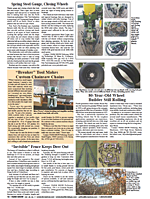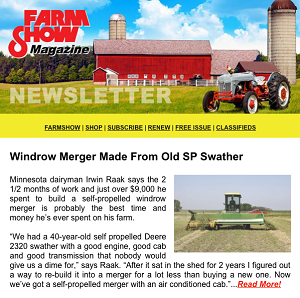You have reached your limit of 3 free stories. A story preview is shown instead.
To view more stories
(If your subscription is current,
click here to Login or Register.)
Woodbender Does Custom Work For Restoration
Shirk’s Woodbending of Narvon, Pa., specializes in transportation components and custom work made through steam bending.
“Steam bending is a time-honored woodworking technique that harnesses the transformative power of heat and moisture to reshape solid wood,” says owner Curvin Shirk. “This method is both a cra
..........
You must sign in, subscribe or renew to see the page.

You must sign in, subscribe or renew to see the flip-book
Woodbender Does Custom Work For Restoration
Shirk’s Woodbending of Narvon, Pa., specializes in transportation components and custom work made through steam bending.
“Steam bending is a time-honored woodworking technique that harnesses the transformative power of heat and moisture to reshape solid wood,” says owner Curvin Shirk. “This method is both a craft and a science, one that bridges the gap between traditional artistry and modern application. By understanding both the process and its many uses, we gain insight into why steam bending remains an essential part of fine woodworking.”
Steam bending involves exposing wood to moist heat, typically by way of a steam chamber, until the fibers become pliable. Steam chambers work like a pressure cooker, heating wood to 230 F at 5 psi.
“We’ve honed the steam-bending process through decades of experience. The softened wood can be gently bent around a form, where it’s clamped and left to cool and dry,” he says. “The wood will retain its new shape without additional fasteners.”
Not only does this preserve the integrity of the wood, but it also allows for elegant, organic curves that are nearly impossible to achieve otherwise. Steam bending also reduces waste, as it uses less material than carving or laminating curved shapes.
Not all wood is suitable. Success depends on the wood’s structure, moisture content and grain orientation.
“We primarily use hardwoods like oak, ash and maple, known for their flexibility and resilience,” Shirk says. “Each board is hand-selected for straight grain and minimal defects, which ensures smooth bends and reduces the risk of cracking or failure.”
Most of his wood comes from small sawmills in Pennsylvania. Lumber from other retailers has been kiln-dried, meaning it cracks instead of bends.
After boards are cut to the required dimensions, they’re placed in a steam box—an enclosure where hot steam circulates around the board.
“The timing can vary, but our general rule is one hour of steaming per inch of thickness,” he says. Immediately after steaming, the wood is removed from the box and transferred to a bending form or jig. “We do this quickly, as the wood cools and stiffens in minutes.”
The wood remains clamped to its form until completely dry, a process that can take several hours or days.
“Then the wood is sanded or trimmed, according to the project’s needs,” Shirk says. “The final product reflects both the precision of the technique and the natural character of the material.”
Shirk primarily makes parts, not complete products. “Our specialty lies in crafting bent wood elements for the transportation industry—a field where both strength and precise form are essential,” he says.
“Steam-bent wood is integral to traditional carriage shafts, providing resilient, shock-absorbing connections between horse teams and carriages. We produce custom wagon wheel parts, where curved wooden segments ensure a seamless, sturdy wheel that rolls smoothly across any terrain. We’ve also provided wood trim for automotive restorations.”
Contact: FARM SHOW Followup, Shirk’s Woodbending, 267 Hammertown Rd., Narvon, Pa. 17555 (ph 717-445-6877; curvin.swb@gmail.com; www.shirkswoodbending.com).
To read the rest of this story, download this issue below or click
here to register with your account number.





